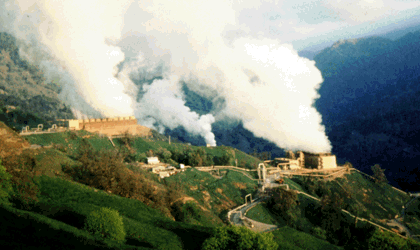
Posted on 08/02/2013 10:41:13 AM PDT by Red Badger
Why isn't there more use of geothermal energy for power plants?
Here's another use for fracking: expanding access to hot rocks deep beneath Earth’s surface for energy production. In April Ormat Technologies hooked up the first such project—known in the lingo as an enhanced geothermal system, or EGS—to the nation's electric grid near Reno, Nev.
"The big prize is EGS," enthuses Douglas Hollett, director of the Geothermal Technologies Office at the U.S. Department of Energy (DoE). "The key is learning how to do it in a reliable way, in a responsible way."
By some estimates, the U.S. could tap as much as 2,000 times the nation’s current annual energy use of roughly 100 exajoules (an exajoule equals a quintillion, or 1018 joules) via enhanced geothermal technologies. With respect to electricity, the DoE concludes at least 500 gigawatts of electric capacity could be harvested from such EGS systems. Even better, hot rocks underlie every part of the country and the rest of the world. Australia's first enhanced geothermal system, spicily named Habanero, began producing power in May, and Europe has brought three such power plants online.
The idea is simple: pump water or other fluids down to the hot rocks beneath the surface. Heat from the rocks turns the water to steam. The steam rises and turns a turbine that spins a magnet to make electricity.
The technology is proved. For years people have turned naturally produced steam from hot springs and the like into electricity. A geothermal power plant in Larderello, Italy, has churned out electricity this way in Tuscany for more than a century, and big power plants can be built this way. The Geysers in California can produce 850 megawatts of electricity alone. But that's because the geothermal resource is close to the surface and obvious, thanks to hot steam rising into the sky.
Although similar natural bounty has turned Iceland into a geothermal powerhouse, there are only so many such sites around. That's where fracking, the controversial practice of pumping fluid underground to shatter shale and release oil or gas, can help. Fracking “enhances” geothermal by making cracks in hot rocks where none existed, allowing heat to be harvested from Earth’s interior practically anywhere, although this reduces the total power produced because of the need to pump water through the system.
As an added benefit, however: geothermal power can run constantly—the hot rocks don't cool very fast—which makes it renewable and predictable. "Geothermal is homegrown, reliable and clean," says Rohit Khanna, program manager at the World Bank for its Energy Sector Management Assistance Program. That is a big part of the reason it is being pursued in developing countries such as Chile, Indonesia, Kenya and the Philippines.
In the case of the Philippines geothermal power now produces nearly 2,000 megawatts, or nearly 20 percent of the country's electricity, thanks to investments that were made in the 1990s. And Kenya, according to its ambassador to the U.S., Elkanah Odembo, would like to derive more than half its electricity from geothermal by 2030. The goal: a combination of geothermal and hydroelectric power that will make them entirely renewably powered. "The potential is there," Odembo promises. He says the Rift Valley contains an estimated 15 gigawatts of potential geothermal power. Nairobi has already become a boomtown for such development.
Yet, geothermal’s abundant, renewable, clean potential for making electricity largely languishes, producing "less than 1 percent of global energy," according to a recent perspective in Science. Indeed, only 6 percent of naturally occurring geothermal resources have been tapped to date, according to Bloomberg New Energy Finance (BNEF).
The reason is simple: money. In addition to the $6-million to $8-million risk of drilling a dry hole or a well that does not produce steam as it should there is the multimillion-dollar expense of building a power plant on top of those wells that do produce steam as they should. That adds up to a total cost for a geothermal power plant of roughly $90 per megawatt-hour, which compares with $67 per megawatt-hour for a natural gas–fired power plant or $144 per megawatt-hour for photovoltaics, according to the DoE's Energy Information Administration.
That number only partially includes the big expense of exploring the geothermal resource in the first place. Gradient holes have to be drilled to explore a particular area. Explosions need to be set off at the surface to send seismic waves through the rock that allow for surveying the underground landscape—a technique familiar from the oil and gas industry. It can take years and millions of dollars to do this exploration with the prospect of earning that money back slowly via electricity sales—or all those funds could be lost. A project by Google and the University of Texas aims to help with that by using public information to develop maps of geothermal potential in the U.S.
BNEF puts the odds of successfully completing a geothermal well at 67 percent, which means one third of all geothermal projects fail. The analyst outfit has called for a "global geothermal exploration drilling fund" of some $500 million provided by investment agencies like the World Bank. Another problem: some EGS projects have been associated with small earthquakes, much like oil and gas drilling and wastewater disposal. That has caused some projects to be abandoned.
As a result, there's a large role to play for supporting research and development to lower risks and improve the technology. The DoE, which invested in Ormat's Nevada project, also has programs to explore how to expand geothermal’s reach. For example, it may be possible to take advantage of lower temperatures from cooler rocks found throughout the subsurface. The hot water co-produced with oil and gas wells could also be used to produce electricity. Slimmer test wells might decrease costs of exploration. Of course, better drilling technology developed for geothermal energy production may find a use in the oil and gas industry first, such as the laser drilling being pioneered with the help of ARPA–E by Foro Energy. In fact, the oil and gas industry may find itself developing technology that can be applied to enhanced geothermal. Their efforts to frack shales and free natural gas or oil require them to understand flow rates of fluid through the rock. "We know that has to tie into what we do," DoE's Hollett notes.
In the end, geothermal development may be best summed up by a song title: “Nice Work If You Can Get It,” says BNEF analyst Mark Taylor. "If you have a great resource, demand for power and secure access to land, it's great. Without any of those things, it's really tough to get geothermal done."
Currently, the best place for enhanced geothermal systems in the U.S. is Nevada, particularly the northern part of the state, where there may well be more sheep than people and the government is a major landowner that favors renewable development. "Nevada in itself is having more projects than almost any country in the world," notes Benjamin Matek, an industry analyst for the Geothermal Energy Association. Maybe that should change.

HOT ROCKS: Geothermal power is abundant, renewable and clean. So why isn't it employed more often? Image: Photograph by Julie Donnelly-Nolan, USGS

Ping!.........
billions of degrees!
Hotter than the surface of the Sun!.....according to top scientist al gore
The Econuts HATE cheap energy!!!! The only thing that they hate worse than cheap energy is abundant energy. It means less government control. Less government control is a fear worse than the fear of Death to environazis.
“Giving society cheap, abundant energy . . . would be the equivalent of giving an idiot child a machine gun.” Paul Ehrlich
Hydraulic fracturing has been used for Geothermal, water well and other uses besides oil/gas for quite some time.
Just guessing but the Yellowstone caldera strikes me as a good location.
I just hope this does not cause the continent to flip over... /sarc
(pssst! Don’t tell anybody, but all that heat down there comes from NUCLEAR ENERGY!)..............
Well, I wouldn’t mind if CALIFORNIA did.......
As well as Hot Springs, AR; Warm Springs, GA; Anywhere, HI; Anywhere, AK.........
My Uncle was involved with this decades ago. For the govt. Around the outskirts of Yellowstone. Angled drilling, the whole works.
Our local bird cage liner ran a green weenie article about smoke emissions and showed a picture just like that of a cooling tower and called the water vapor ie steam “smoke”!
I kid you not!
Warm Springs, OR(Indian reservation and lumber mill) I buy lumber from.

“Geothermal power is abundant, renewable and clean.”
REALLY??? RENEWABLE???
1. Water, like that from which geothermal steam is produced is going to seep back down from the surface to where it interacts with super-hot rocks as fast and as much as the water already there is released in a geothermal energy project? Really? We KNOW that??
2. We can infinitely keep extracting the heat from the rocks from which we derive geothermal energy and the earth will infinitely replace it?? Really??
CLEAN???
The brine from geothermal energy sources is MANY TIMES saltier than sea water; it requires tons of expensive cleaning for the water to be used in steam turbines without causing tons of corrosion to the turbines and the pipes, as well as very high costs in disposing of what’s left of the brine once the water has been extracted, which sometimes has metals within and sometimes other substances toxic in high densities once all the water is removed.
That is not to say that geothermal brine cannot be cleaned, but to say it IS clean to start with is just not the case, and disposal of what is left to make it “clean” is not without high expense either.
There’s this newish technology called a tube and shell heat exchanger. The brackish/briny water never comes in contact with the steam side of the turbine loop, indeed it never leaves the closed (dirty side) heating loop.
It’s only been around for oh, 150 years, so I’m not surprised you haven’t heard of it.
mea culpa
Disclaimer: Opinions posted on Free Republic are those of the individual posters and do not necessarily represent the opinion of Free Republic or its management. All materials posted herein are protected by copyright law and the exemption for fair use of copyrighted works.